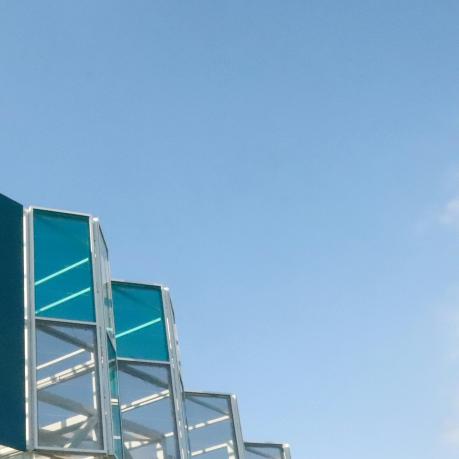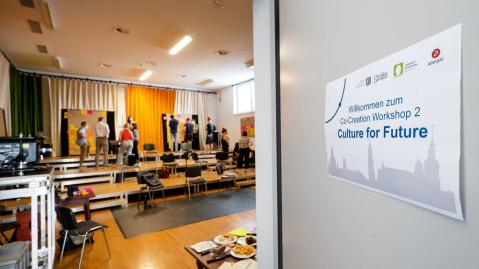
What to look for at COP29: Media Advisory
News publ. 11. Nov 2024
News publ. 28. Sep 2021

The Culture for Future project makes Dresden's cultural sector fit for the future. In this interview, Kathrin Kirsch, a Consultant and Project Manager at adelphi, reports on how the project came about and what it is doing.
Fridays for Future have made climate protection a central issue for society. Other groups have joined the movement, from Parents for Future to Scientists for Future. The movement does not stop at the cultural sector, either: the “Culture for Future” project has now started in Dresden. Kathrin Kirsch, a Consultant and Project Manager at adelphi, reports on how the project came about and what it is doing.
What is the “Culture for Future” project?
More and more areas of our society want to contribute to sustainability. In Dresden, the Office for Culture and Monument Preservation and the Environmental Centre Dresden have decided to find out what the cultural sector can do about it – and then make the necessary changes. For the pilot project, funded by the Council for Sustainable Development, they have selected the Dresden State Operetta, the Museum of Decorative Arts of the State Art Collections Dresden, the Central Library of the Dresden City Libraries, the Dresden Music Festival and the Dresden Philharmonic. adelphi is now helping these five institutions focus on sustainability and climate protection both in their day-to-day work and in their core business. In a co-creation process with Dresden's cultural workers, we develop sustainability strategies with specific actions that, on the one hand, make operational processes more sustainable and, on the other, create a signal effect: climate protection concerns us all and affects all areas of society – including culture.
How did the city of Dresden become aware of adelphi?
Last year we developed our own project, “Climate Intrapreneurship Days”, in which we helped cultural institutions develop their own projects and processes for climate protection. In this context, we organised a session on design thinking at the summer academy of the cultural-political society. There, the city of Dresden noticed us. Our experience and contacts from this in-house project, among other things, helped us to win the bid.
Where did the idea for your in-house project come from?
In the end, the idea came from SEED: in this program, we have been supporting entrepreneurs in emerging and developing countries for almost twenty years in building sustainable companies and leading them to success. We use the so-called toolification approach, a method to develop tools for solving specific problems and then to apply them in different contexts in “co-creation” mode, i.e. together with the members of an organisation. This gives us a whole range of toolkits for sustainable companies. Next we asked ourselves: why shouldn't we also apply this in a different context and in Germany? This became the “Climate Intrapreneurship Days”.
Why are you targeting cultural institutions in particular?
Cultural workers react quickly to social trends. That is why they have had great interest in sustainability issues for some time, especially since Fridays for Future – the name “Culture for Future” is obviously inspired by it. So there is a lot of engagement and motivation. Even the pandemic did not detract from this momentum. On the contrary: many cultural institutions used the lockdown period to promote sustainability initiatives! However, there is often not only a lack of financial resources, but also expertise and structures. Cultural institutions are often faced with the question: we want to make our contribution to sustainability – but where do we start? Whereas a large company might hire an external sustainability consultancy, cultural institutions are left to their own devices.
And that's where adelphi comes in?
Exactly. Because the adelphi tools were developed for precisely these situations: to develop bottom-up solutions, i.e. from the employees, with limited resources and expertise in a co-creation process. The principle that we have already successfully applied in many projects at adelphi is very simple: we bring people together and guide them so that ideas develop into concrete concepts – and where could more creative ideas for sustainable solutions lie dormant than in a group of cultural workers?
What shape will that take?
In this project we offer two types of events. The co-creation workshops with the institutions are key: here we use the tools to guide employees in developing a sustainability strategy that suits their facility and can therefore be successfully implemented and integrated into everyday life. We also offer network events together with the Dresden Office for Culture and Monument Preservation. There, the participants can network with people from other cultural institutions or cities, exchange experiences and share inspiration through practical examples from other institutions and lectures by our adelphi experts. We then use an interactive process to help participants apply this information to their own situation and develop tailored or new solutions.

What role does adelphi play in this?
We are facilitators: we bring the tools and methods, we provide input based on our very wide range of experiences – in this sense, the project is a pilot project for us too, because people from almost all areas of adelphi are actually involved here. When the participants work together, the ideas for concrete implementation on site emerge. The great advantage of this co-creation method is that everyone plays a part. We don’t have one person saying, we do this and that, period. Rather, everyone who will be involved in the implementation actively participates in the idea and planning phase. As a result, everyone feels involved, which of course increases engagement and enables successful implementation.
Can sustainability projects like this or even long-term strategies be implemented completely from the bottom-up?
Only to a certain extent. When it comes to money, the financial sponsors have to be involved. It is not only about implementation, but also about monitoring: regular sustainability reporting requires resources and costs money. And of course, more comprehensive measures require the blessing (and commitment) of the general managers and directors at management level, for example if sustainability criteria are to be included in tenders. It has to come from above.
What about in Dresden?
At Culture for Future, the directorships are involved from the start, as active participants in the co-creation workshops and network events. In addition, both the participating cultural institutions and specifically the city of Dresden want to act as a role model and initiate change that goes beyond this project. This is already reflected in the concept: five institutions were selected that come from five different cultural sectors, so that as many areas as possible are covered and then serve as a template for other cultural workers – and other cities. In addition, a very specific part of the project is to produce guides for these five types of cultural institutions. Based on the strategies that are developed and implemented at Culture for Future, and from the experiences and the lessons we learn (what works, what doesn't, what obstacles are there, what steps do I have to take?), we work with the Dresden participants to develop handouts that will then help others take sustainability and climate protection action in the cultural sector.
Thank you for the interview